Khobragade D. S1* , Potbhare M. S2, Lote S. B1, Pardeshi K. S1. Wankhede S. B1 and Tenpe C. R3
, Potbhare M. S2, Lote S. B1, Pardeshi K. S1. Wankhede S. B1 and Tenpe C. R3
1Datta Meghe College of Pharmacy, Datta Meghe Institute of Medical Sciences(Deemed to be University), Sawangi(M), Wardha, Maharashtra, India.
2GITAM Institute of Pharmacy, Vizag, Andhra Pradesh, India.
3Govt. College of Pharmacy, Amravati, India.
Corresponding Author E-mail: deepak.pharmacy@dmimsu.edu.in
DOI : https://dx.doi.org/10.13005/bpj/2111
Abstract
The effect of antioxidant N-acetyl-D-Glucosamine on haematinic activity of two ayurvedic haematinic preparations Lauha bhasm and mandura bhasm was studied in albino rats. Anaemia was induced by administration of phenyl hydrazine (80 mg/kg for 24 hrs) by intra-peritoneal injection. Changes in body weight, red blood cell count (RBC), white blood cell count (WBC), haemoglobin (HB) concentration and haematocrit (HCT) were analysed as indices of anaemia. The mean cell haemoglobin (MCH), mean cell volume (MCV) and mean cell haemoglobin concentration (MCHC) which are indicators of macrocytosis were calculated accordingly. Phenyl hydrazine induced a significant decrease (P<0.05) in the blood parameters indicating anaemia and also resulted to significant increase (P<0.05) in the macrocytosis parameter. Combination of bhasm with antioxidant induced a significant (P<0.05) increase in the RBC count, HBG concentration, and HCT% which had been originally decreased by phenylhydrazine administration. The macrocytosis also turned towards normal as the animals recovered from anaemic condition. The results obtained suggested that combination of antioxidant N-acetyl-D-Glucosamine with Lauha bhasm & mandura bhasm shows improved haematinic activity.
Keywords
Anaemia; Haematinic Activity; Lauha Bhasm; Mandura Bhasm; N-Acetyl-D-Glucosamine; Phenylhydrazine
Download this article as:| Copy the following to cite this article: Khobragade D. S, Potbhare M. S, Lote S. B, Pardeshi K. S, Wankhede S. B, Tenpe C. R. Preclinical Evaluation of the Effect of Antioxidant N¬-acetyl-D-Glucosamine on Haematinic Potentials of Lauha Bhasm and Mandura Bhasm. Biomed Pharmacol J 2021;14(1). |
| Copy the following to cite this URL: Khobragade D. S, Potbhare M. S, Lote S. B, Pardeshi K. S, Wankhede S. B, Tenpe C. R. Preclinical Evaluation of the Effect of Antioxidant N¬-acetyl-D-Glucosamine on Haematinic Potentials of Lauha Bhasm and Mandura Bhasm. Biomed Pharmacol J 2021;14(1). Available from: https://bit.ly/2Oyrn7h |
Introduction
Anaemia is a global health problem affecting persons of all the age and socio-economic groups worldwide. More than 20% of the world’s population suffers from iron deficiency.1, 2 It has been an major health problem in most tropical countries3, 4 and a common cause of weakness and related issues of poor health in young women.5-8 Regular cycles of women life like menstruation, pregnancy, parturition and lactation demands high physiological needs for iron9-13, and may lead to anaemia if not met.
Ayurveda therapy is aimed at targeting the cause of disease and associated symptoms. In ayurveda, medicines like Punarnavadi Mandur, Tapyadi Loh, Arogya Vardhini and Lohasav are used to increase the RBC count in anaemic pateints. Medicines like Manjishtha (Rubia cordifolia), Patol (Tricosanthe device) Amalaki (Emblica officinalis), Mandukparni (Centella asiatica) used for anaemia act on the “Rakta” (blood) and “Majja”(Nervous) dhatu (tissues) and bone marrow of the body14.
Lauha Bhasm and Mandura Bhasm, the most frequently used Ayurvedic preparation15,16. The effect of both the Bhasms in the management of iron deficiency anaemia in animal model as well as human were found to be very effective 17-21. N-Acetyl D Glucosamine22 has proven antioxidant activities and can be a vital adjuvant in treatment of anaemia. The antioxidants neutralized reactive oxygen species (ROS) by reacting with O2–, NO and peroxynitrite 23-27 and can be very effective in improving anaemic conditions. The study evaluates the effect of antioxidant N-Acetyl D Glucosamine on haematinic activity of Lauha Bhasm and Mandura Bhasm . Phenyl hydrazine (PHZ) is a strong oxidant and is very potent anemia inducing agent. 28-31
Materials and Methods
Materials
Experimental animals
The albino rats (Wistar strain) of both the sex with a weight of about 150-200 g and age of 8 to 10 weeks were used for study. Rats were placed in polypropylene cages with maximum of 5 animals per cage. The animals were fed with a standard animal feed and water “ad libitum” during the complete experimental period. Temperature of 25 + 2ºC and relative humidity of 40-60 % with 12 hrs light dark cycle was maintained in the animal housing area. The study was approved by the Institutional Animal Ethical Committee (Registration No. 535/02/a/CPCSEA/Jan2002).
Chemicals/ Material
The Lauha Bhasm and Mandura Bhasm were procured from the local ayurvedic pharmacy. The chemicals N-acetyl D glucosamine, EDTA disodium, phenylhydrazine, ferrous sulphate were purchased from S.D. Fine chemicals India.All ingredients used were of AR grade and used as received.
Experimental Design
Animal Group: Albino rats were divided into twelve groups of six animals each. The details of animal groups are given in Table no.1. Phenyl hydrazine at 80 mg/kg for 24 hrs by the intra-peritoneal route was injected to eleven groups 2 to 11 for inducing anaemia. Group 1 was administered normal saline solution.
Table 1: Animal groups for study.
| Animal Group | No. Of Animals | Treatment |
| Group 1 | 6 | Distilled water |
| Group 2 | 6 | Phenyl hydrazine |
| Group 3 | 6 | ferrous sulphate 40 mg/kg |
| Group 4 | 6 | N-Acetyl D Glucosamine (NAG) 5mg/kg |
| Group 5 | 6 | Mandura bhasm (MB) 11mg/kg |
| Group 6 | 6 | NAG 5 mg/kg + MB 11mg/kg |
| Group 7 | 6 | Lauha Bhasm LB 11mg/kg |
| Group8 | 6 | NAG 5mg/kg + LB 11mg/kg |
| Group 9 | 6 | Mandura Bhasm (MB) 22mg/kg |
| Group 10 | 6 | NAG 5mg/kg+ MB 22mg/kg |
| Group 11 | 6 | Lauha Bhasm (LB) 22 mg/kg |
| Group812 | 6 | NAG 5 mg/kg + LB 22mg/kg |
The study protocol was for 21 days.
Haematological investigation9,32
Blood samples were collected (1-1.5 ml) in EDTA from the retro-orbital plexus under slight chloroform anaesthesia. Sampling was done on day 0 before phenyl hydrazine administration, and on days 1, 7, 14 and 21, after phenyl hydrazine administration. Red blood cell count (RBC), white blood cells (WBC), haemoglobin (HB) concentration and haematocrit (HCT) were determined using Auto cell counter 920E,
SWELAB Ltd. Mean cell volume (MCV), mean cell haemoglobin (MCH) and mean cell haemoglobin concentration (MCHC) were estimated based on above determined parameters. The average increase in body weights was also evaluated as a sign of improvement in overall health anaemia.
Statistical analysis16,17
One-way ANOVA followed by Dunnett test was used as statistical tool. Results are expressed as the mean ± SEM, n=6. The statistical significance of results was determined at a level of p < 0.05.
Results and Discussion
Lauha bhasm and mandura bhasm are the two most commonly used ayurvedic preparations. Apart from haematinic and astringent, they are used in disorders of liver, spleen and kidney disease. They are also useful in treating intestinal worms, nervous disease, and neuralgia. Being a powerful haematinic and general tonic they are very valuable in the treatment of haemolytic anaemia and jaundice. 9,15
The reported acute toxicity studies as per OECD guidelines and Globally Harmonized System (GHS) for the classification of acute toxic substances, the bhasm were classified in the Category 5 with a LD 50 higher than 2000 mg/kg.33,34 Based on the earlier reports, a lower dose of 11 mg/kg and higher dose of 22 mg/kg was selected in the present study.9 Haematinic activity of both the bhasm was evaluated in vivo in phenyl hydrazine induced anaemic albino rats. Changes in body weight, RBC, HGB, HCT, MCV, MCH , MCHC and WBC were evaluated to assess and compare the haematinic activity.
Changes in body weight
In anaemic patients, the body weight generally decreases and does not increase easily. Improvement or at least maintenance of the body weight in anaemic patients can be a sign of better anaemic control. The study shows both the bhasm and standard drug show improvement in body weight. Mandura bhasm(MB) in combination with NAG has significant improvement in body weight as compared to other treatment groups. The results are depicted in fig. 1.
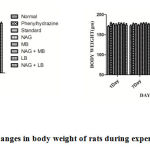 |
Figure 1: Changes in body weight of rats during experimental period. |
Changes in RBC (106/mm3).
The changes in RBC count of experimental animals after treatment are given in fig.2. Increasing the RBC count is one of the most important goals of the treatment of anaemia. Evaluation of RBC count in all animal groups under study indicates that as expected, the standard showed significant effect (p<0.05) on RBCs count. MB and combination of NAG and MB also produced significant increase (p<0.05 and p<0.01 respectively) in RBCs count when compared with anaemic control and other groups. Though NAG, LB and combination of NAG and LB also increases RBCs count but effect was not significant when compared with anaemic control.
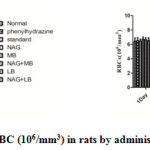 |
Figure 2: Changes in RBC (106/mm3) in rats by administering drugs and bhasm. |
Changes in Haemoglobin level (g/dL).
Depleted haemoglobin is the most important reason which makes anaemia a very challenging health problem and is primarily behind the complications caused by anaemia. NAG, MB and LB when administered individually increases HGB content but effect was not significant when compared with anaemic control. The combination of NAG with MB and LB produced significant increase (p<0.001 and p<0.05 respectively) in HGB content when compared with anaemic control. Standard showed a relatively less significant effect (p<0.05) on HGB content as compared to the combination of NAG with MB. The results are graphically represented in fig.3.
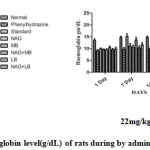 |
Figure 3: Changes in Haemoglobin level(g/dL) of rats during by administering drugs and bhasm. |
Changes in HCT (%)
Hematocrit is decreased in anaemia and any viable treatment for anaemia must be able to restore hematocrit in anaemic condition. From the fig. 4 it can be observed clearly that combination of NAG and MB produced a significant increase (p<0.01) in HCT (%), when compared with anaemic control. Though the standard, NAG, MB, LB and combination of NAG with LB also increases HCT (%) but effect was not statistically significant when compared with anaemic control. Amongst test groups, the LB and NAG combination was better than all the other treatment groups but MB and NAG combination indicating improved efficiency of MB and NAG combination.
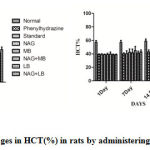 |
Figure 4: Changes in HCT(%) in rats by administering drugs and bhasm |
Changes in MCH
Standard drug and combination of NAG with MB produced a significant decrease (p<0.01) in MCH as compared to anaemic control. Though, NAG, MB, LB and combination of NAG with LB when administered individually also show decreased MCH, the effect was not statistically significant when compared with anaemic control (fig. 5). The results indicate that MB-NAG combination is much superior in reducing MCH.
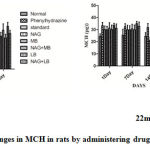 |
Figure 5: Changes in MCH in rats by administering drugs and bhasm. |
Changes in MCHC (g/dL)
Decreasing Mean Cell Haemoglobin Concentration indicates the recovery of anaemia. From fig. 6, It is clear that combination of NAG with MB and LB shows a significant decrease (p<0.01 and p<0.05 respectively) in MCHC. Though, NAG, MB and LB when administered individually also decreased MCHC but the effect was not statistically significant when compared with anaemic control. The MB –NAG combination shows most significant result in reducing MCHC.
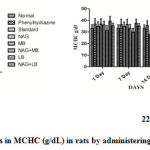 |
Figure 6: Changes in MCHC (g/dL) in rats by administering drugs and bhasm. |
Changes in MCV
The Mean cell volume should decrease significantly if the treatment is good enough for anaemia. Combination of NAG with MB and LB show significant decrease (p<0.001 and p<0.05 respectively) in the mean cell volume when compared with anaemic control. The decrease is significant compared to standard. Though NAG, MB and LB when administered individual also decreases mean cell volume but the results are not significant when compared with anaemic control (fig.7).
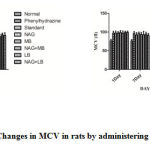 |
Figure 7: Changes in MCV in rats by administering drugs and bhasm. |
Changes in WBC 103/µL
Most of health challenges to body including anaemia results in increased WBC count. Haematinic agent must be able to decrease WBC count in blood or at least prevent it from increasing drastically. Though NAG, MB and LB when administered individual also decrease in WBC count, the effect was not significant when compared with anaemic control. The combination of NAG with MB and LB produced a significant decrease (p<0.01 and p<0.05 respectively) in WBC compared to anaemic control comparable to standard.
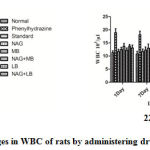 |
Figure 8: Changes in WBC of rats by administering drugs and bhasm. |
The beneficial effect of antioxidant may be due to the preservation of the vascular function and preventing vascular damage by ROS and oxidant species like PHZ radicals.30-35 Another possible explanation can be protecting the membrane integrity of the RBCs36 and stimulation of the erythropoisis process31. Thus the bhasm and antioxidant in combination not only exerted its inherent anti anaemic activity but also might have neutralized the free radicals generated by PHZ by blocking lipid peroxidation and free radical generation and thus protecting RBCs haemolysis.
These mechanisms explain the anti-anaemic properties of the combination of bhasm and antioxidant in the current study. To summarize, the present study provides the evidence that the antioxidant and hematinic agent like bhasm could reduce oxidative stress and thus aid in prevention of hemolytic anemia by improvement of normal hemoglobin level, red blood cells count, and hematocrit percent and other related parameters.
In light of the results, the study indicated that co-administration of antioxidant N-Acetyl D Glucosamine & bhasm show significant haematinic activity.
Conclusion
The study indicates that not only the standard drug but both Mandura Bhhasm and Lauha Bhasm in combination with antioxidant N-Acetyl D Glucosamine combination significantly increased the haematinic activity with the significant increase in blood RBC, HGB and the % HCT count. Haematinics may be used in synergistic combination with antioxidant for effectively treating anaemia and anaemia related complications.
Among the Mandura Bhasm and Lauha Bhasm, Mandura bhasm when used in combination with N-acetyl D-glucosamine (5mg/kg) showed comparatively significant improved haematinic activity even at the low dosage, in anaemic rats. Further investigation and appraisal regarding the mechanism of action of antioxidants in combination with haematinics for the treatment and management of anaemia is still needed.
Acknowledgement
The authors would like to acknowledge that the HOI and all technical and supporting staff of animal house for supporting wholeheartedly during this study.
Conflict of Interest
The authors would like to ensure that there are no conflicts of interests with anybody regarding the honorarium, grants, membership, employment, ownership of stock or any other interest or non‐financial interest such as personal or professional relation, affiliation, knowledge of the research topic and content and authorship of research paper.
Funding Source
The research work was self funded and no any type of funding was granted by any funding agency private or government.
References
- Kapur D.P, Agarwal K.N and Agarwal D.K. Nutritional anemia and it control. Ind. J. Ped, 2002; 69: 607–616.
CrossRef - Grantham M.C, Gregor S and Ani C. A review of studies on the effect of iron deficiency on cognitive development in children. J. Nutri, 2001; 131: 649S-668S.
CrossRef - Mehta B.C. Effects of iron deficiency apart from anaemia and the concept of iron deficiency disease. Acta. Hematol, 1983; 70: 189-193.
CrossRef - Patel J.C and Mehta B.C. Anemia in a population of low socioeconomic status. Ind. J. Med. Sci, 1969; 23: 349-60.
- Basta S.S, Karyadi D and Scrimshaw N.S. Iron deficiency anemia and the productivity of adult males in Indonesia. American J. Clin. Nutri, 1979; 32: 916–925.
CrossRef - Bhatt, A., N. Vinayak, and N. Acharya. Role of Intravenous Iron Sucrose in Comparison to Oral Ferrous Sulfate for Prophylaxis of Anemia in Pregnant Women. J. D. M. I. M. S. University,2020; 15(1): 12–15.
- Jaiswal, S., S. Banait, and S. Daigavane. A Comparative Study on Peripapillary Retinal Nerve Fiber Layer Thickness in Patients with Iron-Deficiency Anemia to Normal Population. J. D. M. I. M. S. University, 2018 ;13(1)): 9–11.
CrossRef - Varma, A., J. Vagha, A. Agrawal, R. Meshram, S. Damke, and S. Thakur. Sociodemographic Determinants in Prevalence of Anemia in Adolescents of Rural Area of Maharashtra. J. D. M. I. M. S. University, 2018 ;15(2): 209–14.
CrossRef - Cogswell M.E, Parvanta I, Ickes L, Yip R and Brittenham G.M. Iron supplementation during pregnancy, anemia, and birth weight: A randomized controlled trial. American J. Clini. Nutri, 2003; 78: 773–781.
CrossRef - Baliga, S., M. Chaudhary, S. Bhat, P. Bhansali, A. Agrawal, and S. Gundawar. Estimation of Malondialdehyde Levels in Serum and Saliva of Children Affected with Sickle Cell Anemia. J.Ind. Soc. Prev. Dent. 2018; 36(1): 43–47.
- Chiwhane, A., S. Burchundi, G. Manakshe, and H. Kulkarni. Incremental Prognostic Value of Anemia in Acute Coronary Syndrome from a Rural Hospital in India. Glo. Heart.2020; 15(1).
CrossRef - Singh, A., A. Agrawal, and Y.S. Kale. Effects of Iron Deficiency Anemia on HBA1C Levels in Non-Diabetic and Diabetic Patients. Int. J. Pharm. Res.,2019; 11(1): 1187–92.
- Wajpeyi, S.M., P. Badwaik, and M. Patil. Protocol for Evaluation of Comparative Efficacy of Dietary Supplement Acquired from Kitchen Garden (Parasbag) and GudharitakiAwaleha in Pandu Roga (Iron Deficiency Anemia). Eur. Jo.Mol.Clin.Med., 2020; 7(7): 2122–29.
- Indian herbal Pharmacopoeia, revised new edition. Indian drug Manufacturers association Mumbai,2002; 88-97.
- Potbhare M.S , Tenpe C.R and Khobragade D.S. Evaluation of Ayurvedic preparation lauha bhasma as a potential haematinic agent. International Journal of Pharmacological Research, 2016;Volume 6 Issue 12.
- Sarkar P.K, Prajapati P.K, Choudhary A.K, Sukla V.J and Ravishankar Haematinic evaluation of lauha bhasma and mandura bhasma on Hg-Cl2 induced anemia in rats. Ind. J. Pharma, Scie, 2008; 791-795.
CrossRef - Hamdy W, Tantawy E.L and Temraz A . Treatment of Experimental Hemolytic Anemia by Some Antioxidant Drugs. Journal of Pharmacy Research, 2009; 2(5),798-802.
- Inamdar N, Edalat S, Kotwal V and Pawar S. Care with Nature’s cure: Herbal Drugs, Phcog. Rev, 2007; 1(2): 361-368.
CrossRef - Jain S.P. Ethnaomedicinal Plants of Jaunsar-Bawar Hills, Uttar Indian J. Ethnopharmacol, 1984; 122: 213-222.
CrossRef - Potbhare M.S , Khobragade.D. In Vitro Evaluation of Antioxidant Potential of Ayurvedic Preparations Lauha Bhasma and Mandura Bhasma. Asian J. Pharm. Res, 2017; 7(2): 63-66.
CrossRef - Potbhare M. S, Phendarkar N and Khobragade In vitro Evaluation of Antioxidant Potential of N –Acetyl-D-Glucosamine. Asian J. Res. Pharm. Sci, 2017; Vol. 7: Issue 2.
CrossRef - Hanasaki Y, Ogawa S and Fukui S. The correlation between active oxygens scavenging and antioxidative effects of flavonoids. Free Rad. Biol. Med, 1994; 16: 845–850.
CrossRef - Vanaker S.A, Tromp M.N, Haenen G.R, Vijgh W.J and Bast A. Flavonoids as scavengers of nitric oxide radical. Biochem. Biophys. Res. Commun, 1995; 214: 755-759.
CrossRef - Hanasaki Y, Ogawa S and Fukui S. The correlation between active oxygens scavenging and antioxidative effects of flavonoids. Free Rad. Biol. Med, 1994; 16: 845–850.
CrossRef - Ardanaz N and Pagano P.J. Hydrogen peroxide as pacrrine vascular mediator: regulation and signaling leading to dysfunction. Exp. Biol. Med, 2006; 23: 237–251.
CrossRef - Vanaker S.A, Tromp M.N, Haenen G.R, Vijgh W.J and Bast A. Flavonoids as scavengers of nitric oxide radical. Biochem. Biophys. Res. Commun, 1995; 214: 755-759.
CrossRef - Jain S.K and Subrahmanyam D. The mechanism of phenylhydrazine Induced hemolytic anaemia. Biochem. and Biophys. Res Commun, 978; 82: 1320-1324.
CrossRef - Itano H.A, Hirota K and Hosokawa K. Mechanism of induction of haemolytic anaemia by phenylhydrazine. Nature, 1975; 56: 665–667.
CrossRef - Parodi S, Flora D.S, Cavanna M, Pino A, Bennicelli C and Brambilla G. DNA-damaging activity in vivo and bacterial mutagenicity of sixteen hydrazine derivatives as related quantitatively to their carcinogenicity. Can. Res, 1981; 1469–1482.
- Patil S, Kanase A, Kulkarni P.H. Antianaemic properties of Ayurvedic drugs, raktavardhak, punamavasav and navayas louh in albino rats during phenylhydrazine induced haemolytic anaemia. Ind. J. Exp. Biol, 2000; 38: 253-257.
- Diallo A, Gbeassor M, Vovor A, Gadegbeku K.E, Aklikokou K and Agbonon A. Effect of Tectona grandis on Phenyl hydrazine induced anaemia in rats. Fitoterapia, 2008; 79: 332-336.
CrossRef - OECD Guideline for testing of chemicals, acute oral toxicity–fixed dose procedure, 420, Organization for Economic Co-operation and development, Paris, Dec. 2001.
CrossRef - OECD–Harmonized Integrated Hazard classification system for Human Health and Environmental Effects of Chemical Substances–as endorsed by the 28th joint meeting of the Chemicals Committee and working Party on Chemicals, November 1998.
CrossRef - Nissim J.A. Physico-chemical properties and toxicities of different iron preparations. J. Pharmacol,1953; 8: 197.
CrossRef - Tantawy W.H and Temraz A. Treatment of Experimental Hemolytic Anaemia by some Antioxidant Drugs. J. Pharm. Res, 2009; 2 (5): 798-802.
- Forstermann Uand Munzel T. Endothelial nitric oxide synthase in vascular disease from marvel to menace. Circ., 2006;113:1708-1714.
CrossRef








